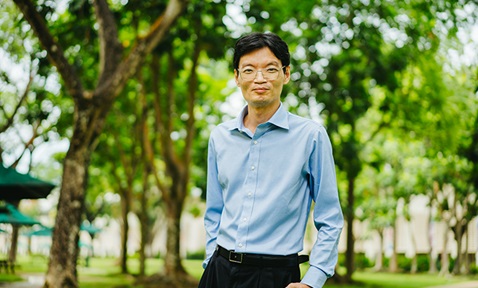Try these practical strategies for raising bilingual kids
SINGAPORE – As a Malay-language teacher, Madam Faridah Mohamed Ali, 32, knows how challenging it can be to raise kids who are fluent in both their mother tongue and English.
So when she is at home with her three children, aged seven, five and four, she tries her best to incorporate fun and games into their learning.
When she saw how much her children enjoyed reading home-grown author Far’ain Jaafar’s Satay, which is written in English and Malay, she got them to make their own satay using play dough. She also conversed with them using words from the book.
The story is set in East Coast Lagoon Food Village, a place Madam Faridah’s family frequents, and her children could identify with that.
“My children were excited because of the familiarity, which made the reading experience meaningful. It is in these little everyday moments that language really comes alive,” says the Fuhua Primary School teacher, who won the Ministry of Education’s (MOE) Arif Budiman Malay Language Teacher Award 2024.
The award recognises teachers for their outstanding contributions to the teaching and learning of the Malay language.
Making language learning fun requires more than just memorising vocabulary and grammar, says Madam Faridah, who is married to Mr Luqman Hakim Shaid, 34, an assistant service engineer.
“It is how we can integrate language into meaningful experiences that engage students in a natural and enjoyable way,” she adds.
Despite speaking to her children in Malay and English since they were born, she says her kids tend to speak to her in English when they return home from school.
“It is common for children to instinctively switch to the dominant language at home – often English – despite our best efforts,” she says.
She would then respond to them in Malay, to encourage them to converse in their mother tongue.
“As parents, we persevere, knowing that our children are the future bearers of the language and culture. Progress may sometimes feel slow, but every effort we make today helps keep the language alive and thriving,” says Madam Faridah, who has been teaching for six years.
Another parent, Ms Wendy Seah, 41, a human resources executive director, tries to provide her children with ample opportunities to practise their mother tongue.
She and her husband, Mr Ng Wei Guo, 41, a business development manager, have four children – Makayla, 11, Matilda, nine, and five-year-old twins Matthias and Marcela.
The children are cared for by Ms Seah’s mother, who speaks to them in Mandarin.
They attend enrichment lessons at the Singapore Hokkien Huay Kuan Arts and Cultural Troupe, which offers lessons in activities such as wushu, taiji, guzheng and dance conducted in Mandarin.
Ms Seah encourages her children to place their orders in Mandarin when they buy food at hawker centres.
“We didn’t put together a concrete language plan, but we gave them the exposure and opportunities to learn through different avenues,” she says.
Her children borrow an almost equal number of English and Chinese storybooks during their fortnightly library visits. If they like a particular character, for instance, Peppa Pig, Ms Seah gets them to read the Chinese version of the stories.
“We speak to them in Mandarin, and we also emphasise that if someone asks them a question in Mandarin, they have to respond in Mandarin,” she says.
Screen time for her children includes Mandarin news, documentaries and variety shows, she says.
Language aside, Ms Seah says she makes it a point to inculcate Chinese culture and values in her children, for instance, greeting elders before a meal.
“Learning a language is not just speaking, it’s knowing the culture, the history, the values behind it,” she adds.
Foster a fun, bilingual environment at home
With English being the dominant language spoken in school, parents can balance the exposure by providing opportunities for their children to pick up their mother tongue at home, say experts.
Tamil-language teacher Saratha Raman Sariyan from Woodgrove Primary School has been teaching for 25 years. She suggests that parents incorporate simple phrases, such as saying “time for breakfast”, in their mother tongue.
They can also introduce food names in both English and their mother tongue, adds Madam Saratha, who was the recipient of the MOE’s Most Inspiring Tamil Teachers’ Award 2024.
She encourages parents to create a bilingual environment by providing consistent exposure through creative ways.
For instance, play a “word of the day” game where each mealtime includes a new word; or, when reading stories, try to do so in both languages.
“To make language learning interactive, children can act out stories or use puppets to enhance their storytelling,” she says.
Parents can also play board games or card games with their children in their mother tongue; do arts and crafts while introducing colours, shapes and instructions in the mother tongue; or create a “language jar” where their child can choose a fun learning activity each day.
Madam Saratha says a good way to encourage children is to celebrate their progress, no matter how small.
“When they achieve new milestones, such as learning 10 new words, parents can reward them with small treats, such as stickers or snacks,” she adds.
She says that the key to making language learning fun is to keep it engaging and stress-free.
Two strategies to keep in mind
Parents who may be at a loss as to how to start, can consider two broad strategies, says Madam Teo Ting Ting, a former Chinese-language teacher who wrote and published the book, Empowering Bilingual Connections, in 2024.
The first strategy is the “time and place” method, where families can dedicate specific times or settings – such as game nights, relaxed weekends or fun activities at home – to using the less dominant language.
“This approach creates a natural and consistent way for children to practise the language in a meaningful context,” she says.
The second commonly used strategy is the “one parent, one language” approach, where each parent consistently speaks a different language to the child, which will help the child clearly associate each language with a specific parent.
Parents who are keen on this approach should evaluate their family dynamics to ensure balanced language exposure.
Madam Teo says: “If the parent speaking the less dominant language has less interaction time, the child might struggle to develop fluency in that language.”
Approaches for each age group
Infants to toddlers
Research has found that human brains are capable of learning two languages simultaneously without limiting the mastery of either. Hence, it is beneficial for infants and toddlers to be exposed to multiple languages as early and as often as possible, says a researcher.
Dr Sun Baoqi, an education research scientist from the National Institute of Education’s centre for research in child development, says language comprehension abilities develop rapidly during this stage, enabling the young ones to quickly absorb various words and phrases.
“Ensure that each language is used sufficiently throughout the day to avoid a preference for one language,” she says.
Consider radio broadcasts and television programmes to supplement language exposure.
She suggests parents speak to their baby about things they are interested in and to describe them extensively.
“Observe the baby’s body language and expressions, and engage in responsive communication, including verbal speech and gestures,” she says.
From as early as four months old, introduce the child to picture books with simple and bright colours.
For toddlers, opt for books that are sturdy enough to withstand their biting and pulling. Begin with narrating the plot of a story simply, and then progress to reading according to the text.
“Introduce audio books for familiar stories, or consider recording your own voice reading the stories, as a parent’s voice is engaging,” she says.
Pre-schoolers
Madam Faridah makes language learning hands-on for her pre-schoolers by using art materials to create alphabet books to teach them phonics.
For instance, when learning the sound C for “cawan” (cup in Malay), she gets her children to collect recycled cups and paste them onto the letter “C” as a fun activity.
“To make the learning process even more engaging, I record short videos of their creations, so they can watch them later and feel proud of their work,” she says, adding that these interactive moments make language learning memorable and enjoyable.
Madam Saratha says parents can try activities including role-playing; creating a song playlist in the mother tongue; watching videos with or without subtitles as a family and having follow-up discussions on it; and creating a cosy reading corner with books in both languages.
“Every child learns differently, so parents can try a variety of learning activities and see what the child enjoys most,” she says.
Lower primary
Parents should monitor their child’s progress in both languages as they enter primary school, says Dr Sun.
Ensure that children have adequate time and access to reading materials, as this encourages a habit of reading beyond the classroom.
“Choose books that challenge their abilities just enough to promote learning without causing them frustration,” advises Dr Sun.
For many children, reading mother tongue books independently may still be challenging.
“Continuing with shared reading can support their language development,” she says.
Parents should ensure that their children are adequately exposed to both languages, with an emphasis on the mother tongue if that is the weaker language.
This can be done through regular conversation, storytelling and activities.
At this age, parental support with homework will help children feel more competent and motivated, she says.
Upper primary
The English reading skills of upper primary pupils are usually well developed, while their proficiency in mother tongue languages may still be progressing, says Dr Sun.
To monitor a child’s proficiency in both languages, parents should observe not only their academic performance, but also their fluency in using both languages daily, she adds.
Parents should continue to support their child’s mother tongue progress by providing access to level-appropriate reading materials.
Incorporating TV shows and films can make language practice more enjoyable and relatable.
Madam Saratha says parents could encourage their child to keep a bilingual diary or blog; or to write stories, poems or song lyrics in their mother tongue.
“Developing bilingualism requires patience and consistent development. Children who continue to use both languages in adulthood will carry with them the cognitive, academic and social advantages of being bilingual,” she adds.
This is the second of a two-part series on how parents can raise bilingual children. Read the first part here.
- Jane Ng is a senior correspondent at The Straits Times who covers parenting and education stories. She also writes a regular column, Minor Issues, where she mulls over her own parenting dilemmas.
Source: The Straits Times © SPH Media Limited. Permission required for reproduction.
Read the original article here.





.tmb-listing.jpg?Culture=en&sfvrsn=13b00373_1)

.tmb-listing.jpg?Culture=en&sfvrsn=15e6d6d7_1)